The AMD A10-7700K and AMD A6-7400K CPU Mini-Review
by Ian Cutress on May 27, 2015 9:00 AM ESTGaming Benchmarks
As mentioned previously, this mini-review will focus on a few elements but all our data can be found in Bench, including tests with high end ($300+) graphics cards and some 4K testing.
Alien: Isolation
If first person survival mixed with horror is your sort of thing, then Alien: Isolation, based off of the Alien franchise, should be an interesting title. Developed by The Creative Assembly and released in October 2014, Alien: Isolation has won numerous awards from Game Of The Year to several top 10s/25s and Best Horror titles, ratcheting up over a million sales by February 2015. Alien: Isolation uses a custom built engine which includes dynamic sound effects and should be fully multi-core enabled.
For low end graphics, we test at 720p with Ultra settings, whereas for mid and high range graphics we bump this up to 1080p, taking the average frame rate as our marker with a scripted version of the built-in benchmark.
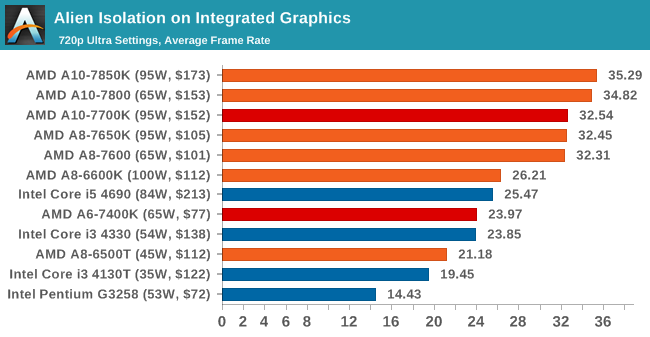
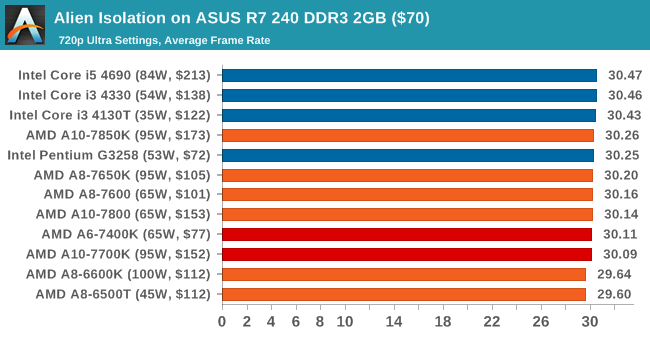
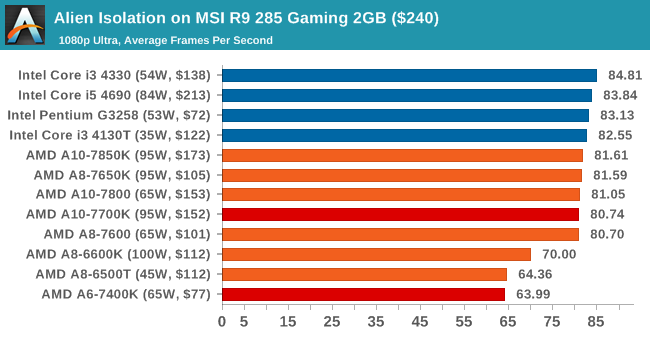
Total War: Attila
The Total War franchise moves on to Attila, another The Creative Assembly development, and is a stand-alone strategy title set in 395AD where the main story line lets the gamer take control of the leader of the Huns in order to conquer parts of the world. Graphically the game can render hundreds/thousands of units on screen at once, all with their individual actions and can put some of the big cards to task.
For low end graphics, we test at 720p with performance settings, recording the average frame rate. With mid and high range graphics, we test at 1080p with the quality setting. In both circumstances, unlimited video memory is enabled and the in-game scripted benchmark is used.
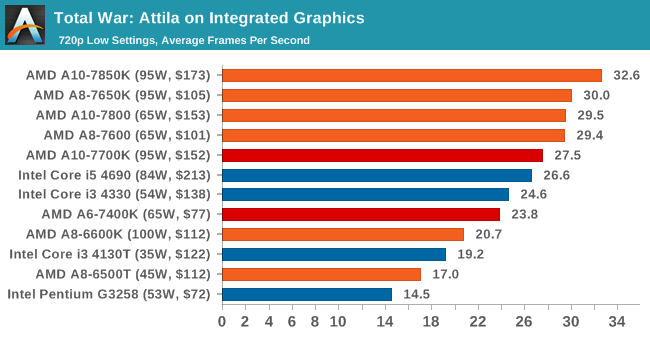
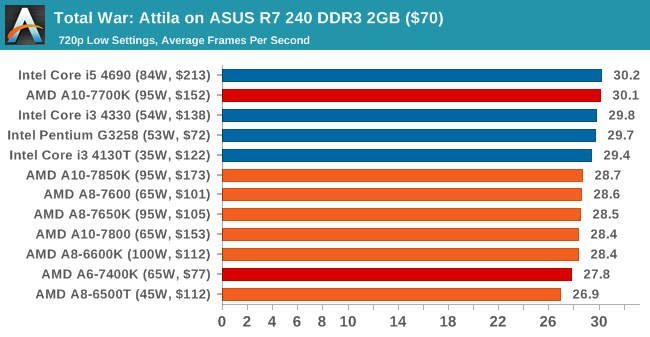
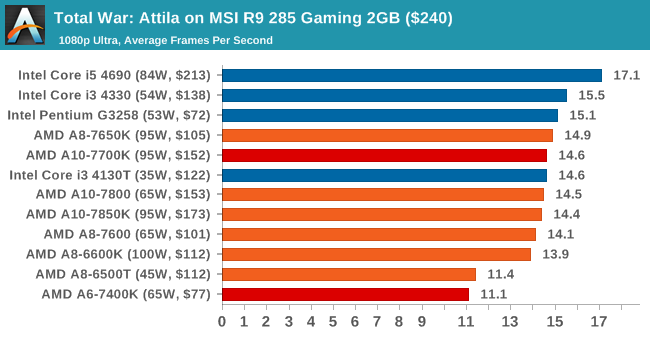
Grand Theft Auto V
The highly anticipated iteration of the Grand Theft Auto franchise finally hit the shelves on April 14th 2015, with both AMD and NVIDIA in tow to help optimize the title. GTA doesn’t provide graphical presets, but opens up the options to users and extends the boundaries by pushing even the hardest systems to the limit using Rockstar’s Advanced Game Engine. Whether the user is flying high in the mountains with long draw distances or dealing with assorted trash in the city, when cranked up to maximum it creates stunning visuals but hard work for both the CPU and the GPU.
For our test we have scripted a version of the in-game benchmark, relying only on the final part which combines a flight scene along with an in-city drive-by followed by a tanker explosion. For low end systems we test at 720p on the lowest settings, whereas mid and high end graphics play at 1080p with very high settings across the board. We record both the average frame rate and the percentage of frames under 60 FPS (16.6ms).

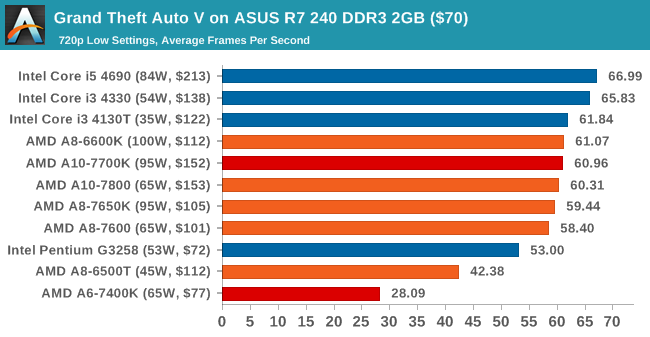
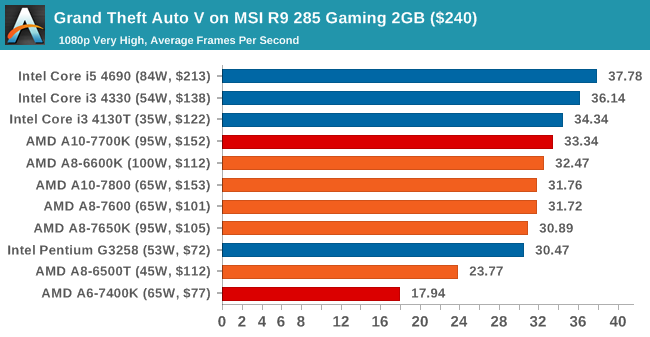
GRID: Autosport
No graphics tests are complete without some input from Codemasters and the EGO engine, which means for this round of testing we point towards GRID: Autosport, the next iteration in the GRID and racing genre. As with our previous racing testing, each update to the engine aims to add in effects, reflections, detail and realism, with Codemasters making ‘authenticity’ a main focal point for this version.
GRID’s benchmark mode is very flexible, and as a result we created a test race using a shortened version of the Red Bull Ring with twelve cars doing two laps. The car is focus starts last and is quite fast, but usually finishes second or third. For low end graphics we test at 1080p medium settings, whereas mid and high end graphics get the full 1080p maximum. Both the average and minimum frame rates are recorded.

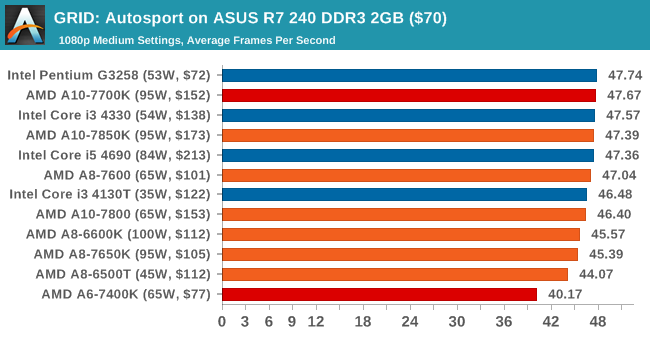
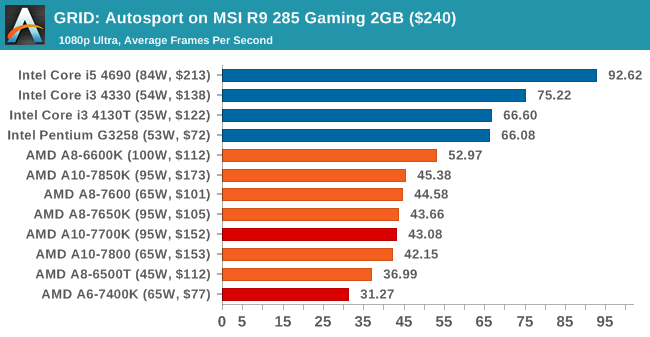
Middle-Earth: Shadows of Mordor
The final title in our testing is another battle of system performance with the open world action-adventure title, Shadows of Mordor. Produced by Monolith using the LithTech Jupiter EX engine and numerous detail add-ons, SoM goes for detail and complexity to a large extent, despite having to be cut down from the original plans. The main story itself was written by the same writer as Red Dead Redemption, and it received Zero Punctuation’s Game of The Year in 2014.
For testing purposes, SoM gives a dynamic screen resolution setting, allowing us to render at high resolutions that are then scaled down to the monitor. As a result, we get several tests using the in-game benchmark. For low end graphics we examine at 720p with low settings, whereas mid and high end graphics get 1080p Ultra. The top graphics test is also redone at 3840x2160, also with Ultra settings, and we also test two cards at 4K where possible.

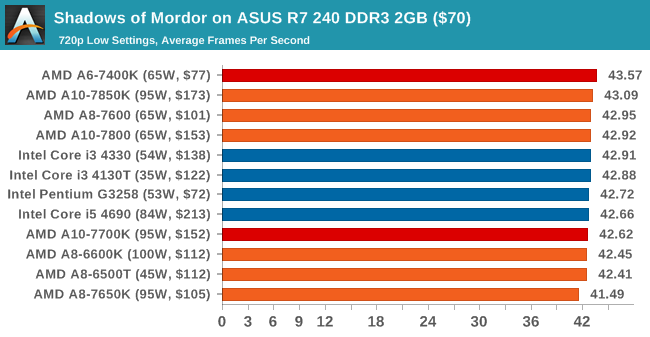
![Shadows of Mordor on MSI R9 285 Gaming 2GB ($240) [Minimum FPS]](https://images.anandtech.com/graphs/graph9287/74558.png)
I added some 4K numbers here, just to see the difference at a higher resolution. It turns out that for average frame rates at least, Shadows of Mordor is CPU agnostic. A fast CPU gets a higher rating in minimum frames however.







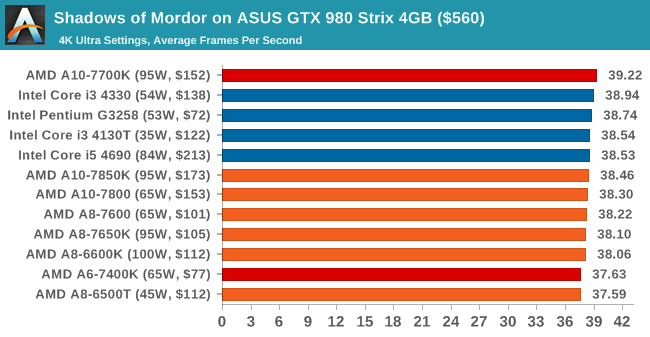
![Shadows of Mordor on ASUS GTX 980 Strix 4GB ($560) [Minimum FPS]](https://images.anandtech.com/graphs/graph9287/74592.png)








105 Comments
View All Comments
Edens_Remorse - Wednesday, May 27, 2015 - link
8370e($120) + ASRock 970M Pro 3 mATX($15... yes $15) and a Raijintek Pallas CPU cooler($33) is an absolute monster combination that will only get better with dx12. Show me a combination that comes close to that performance for anywhere near the price. I loved my 4790k, but appreciating what one has in no excuse for ignorance.azazel1024 - Wednesday, May 27, 2015 - link
Which may be a long time in coming. I look forward to it, but with GPUs being limited to 4GB in the first itteration, that is a heck of a limitation for system RAM. Once 8 or 16GB is possible, it seems more realistic...but also going to be a thwacking expensive chip. Maybe it'll be cheaper than if you bought RAM and CPU seperately...but you can hang on to that RAM for a couple of CPU/board upgrades and with HBM, you have to replace it each time.For a replacable SoC/CPU, I think your best bet is better L3/SRAM and leave the memory slotted. Even when considering iGPUs. Soldered SoC/CPU HBM may make sense.
extide - Wednesday, May 27, 2015 - link
I would bet that an APU with HBM will also have DDR3/4 -- it would use it as like an L3/L4 cache, or maybe only use it for graphics.Refuge - Wednesday, May 27, 2015 - link
HBM isn't going to come to APU's for a few more years at least.Not from AMD that is, although, with how they tend to re-badge and reuse, you may still get your wish to see a Zen core with HBM... lol
Gc - Wednesday, May 27, 2015 - link
Ian, NPB scores beg for an explanation or a correction.Edens_Remorse - Wednesday, May 27, 2015 - link
Why are you reviewing old tech when the new model comes out tomorrow?shadowjk - Wednesday, May 27, 2015 - link
Even if it comed out tomorrow, it will be months before most people can actually buy it, by which time there's something else that's coming out "tomorrow". Reviews of actual products, that can actually be bought, is useful for anyone about to buy a new cpu/apu.Of course, in an ideal world, these would have been benchmarked earlier. Better late than never, I guess..
Edens_Remorse - Wednesday, May 27, 2015 - link
False. You can buy the 7870k today. It even runs on some previous generation FM2+ mobos. Visit cpu-world if you don't want to take my word for it. There are also multiple motherboard manufacturers with new boards specifically for Godavari. This article is completely suspect.ToTTenTranz - Wednesday, May 27, 2015 - link
Why do you blatantly refuse to put up a single Mantle-enabled game to see how lower-performance CPUs (like the ones reviewed) fare in it, as a preview of what to expect in DX12 and Vulkan?And where are the results with dual-graphics turned on for the A10 7700K?
You mention dual-graphics in the first page and the conclusion, but are they turned on in the gaming results?
There's no comparison with the 7700K with and without dual-graphics turned on? It didn't work at all? I don't get it.
Yes, Intel CPUs fare better in DX11 and AMD CPUs using discrete graphics cards. We know.
We've known that for years.
Now we know it hasn't changed, ever since the last guy who made the exact same tests on the exact same (non-Mantle, non-Crossfired) conditions, which was probably last week or something.
I love Anandtech, but this review is useless the way it's done, Ian.
Guspaz - Wednesday, May 27, 2015 - link
Mantle is a dead API (having been supplanted by DX12 and Vulkan) that is only supported by a handful of games... It doesn't make sense to revamp their benchmark suite just to test on something that has limited utility and no future.